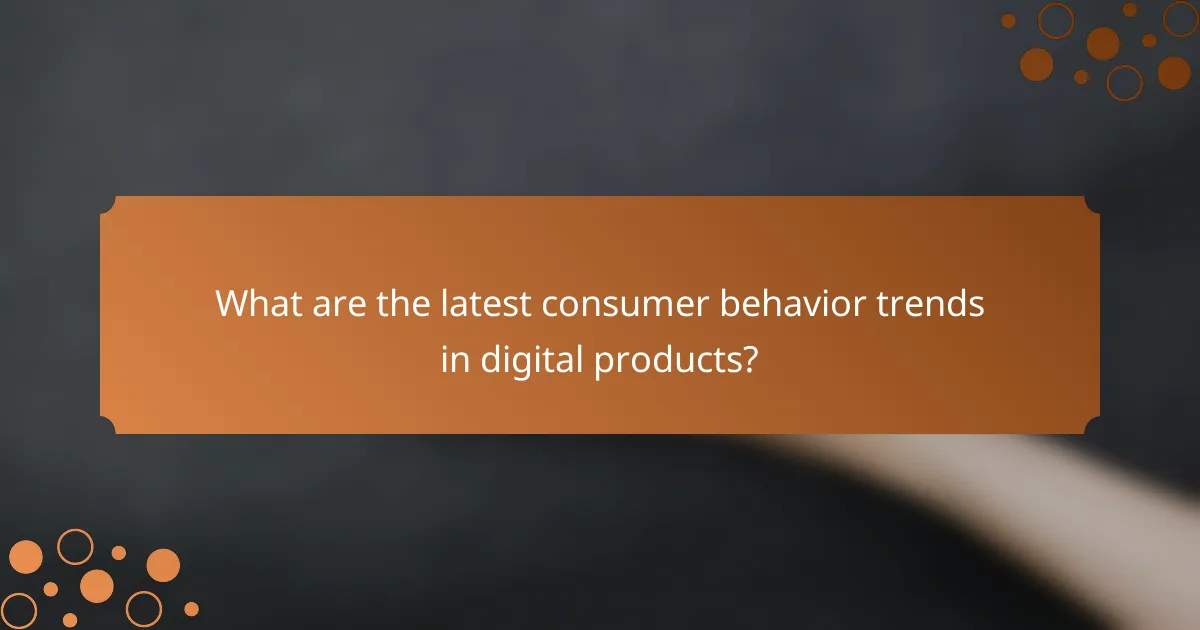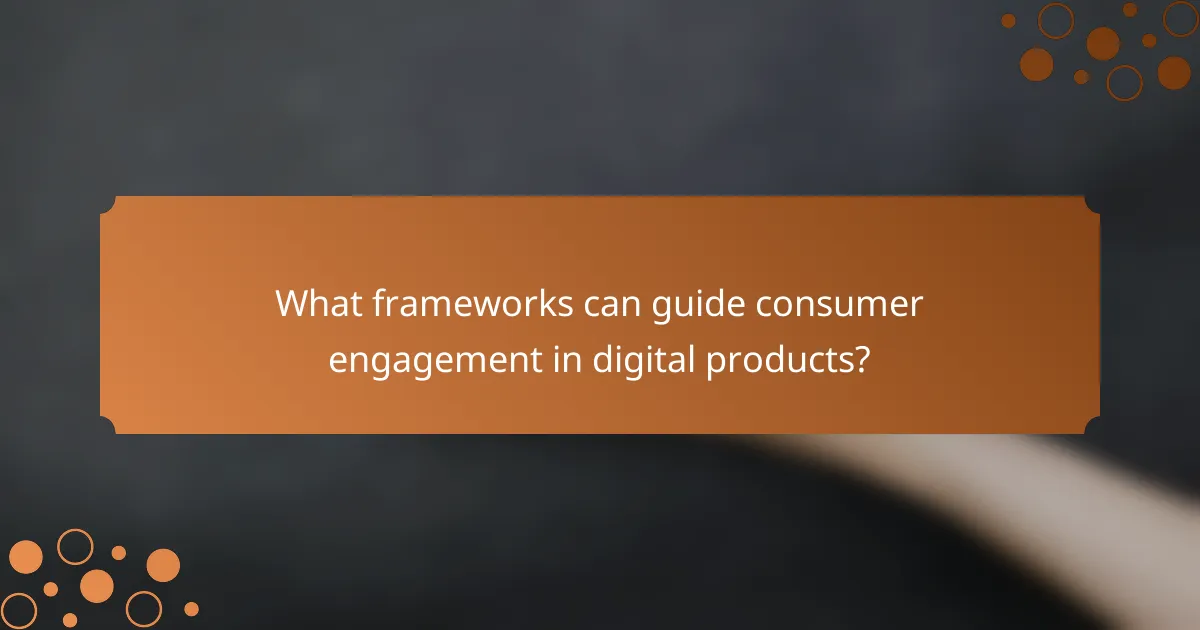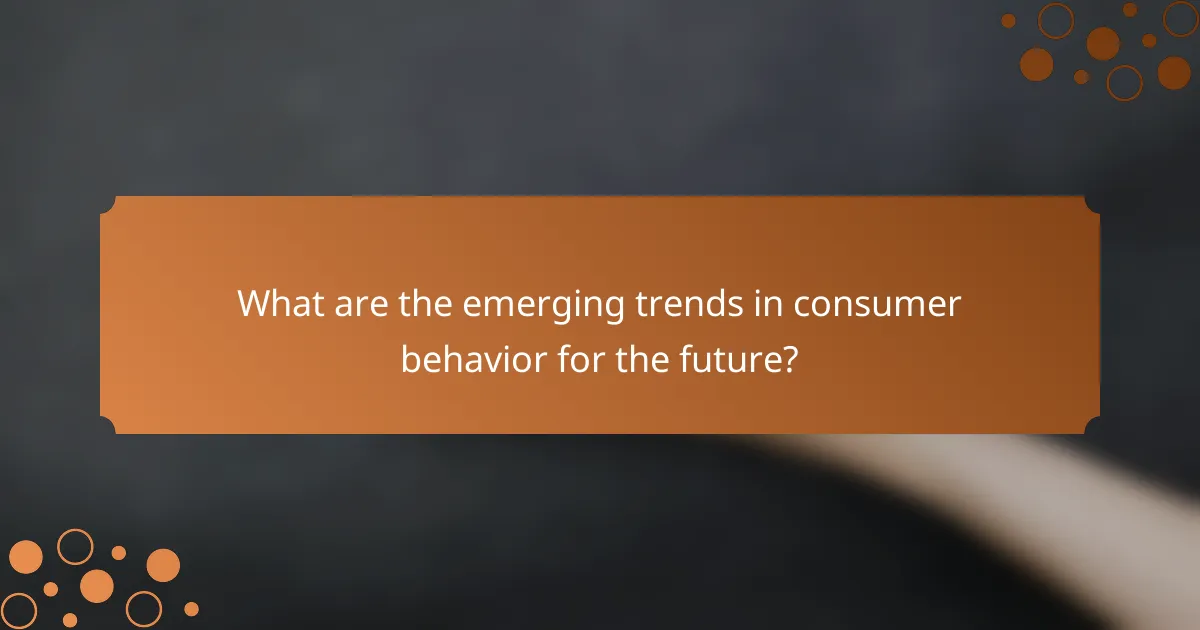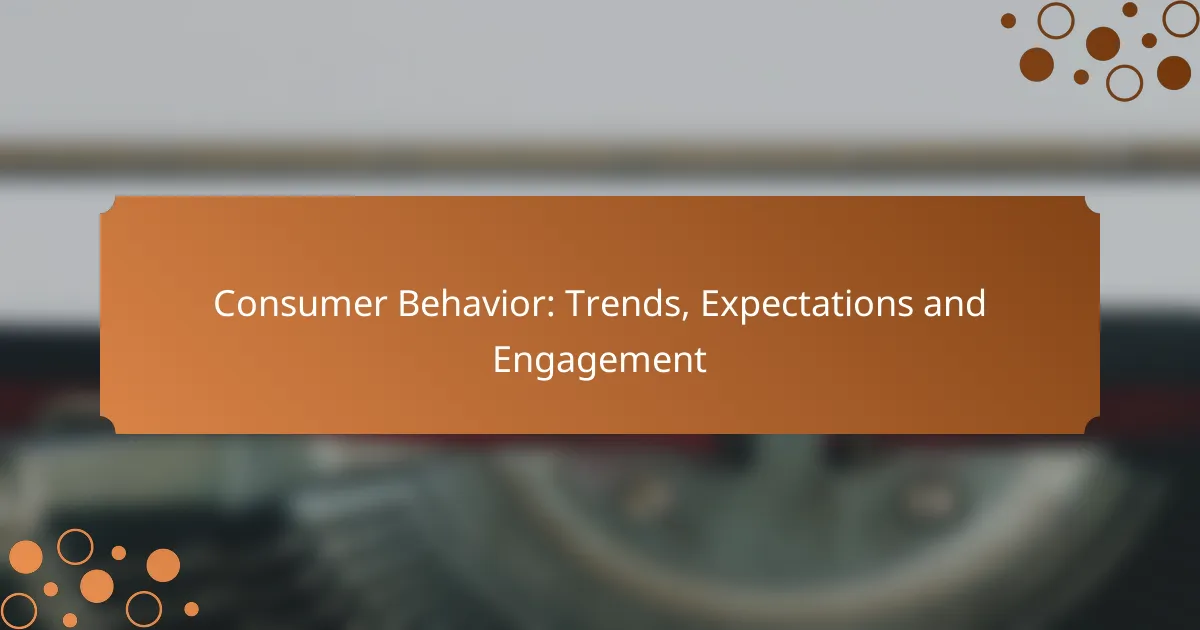Understanding consumer behavior is essential for businesses aiming to thrive in today’s competitive landscape. Recent trends indicate a growing demand for personalization, mobile-first solutions, and sustainable practices, which shape consumer expectations and influence product development. By aligning offerings with these evolving preferences, companies can enhance user engagement and drive long-term success.

What are the latest consumer behavior trends in digital products?
The latest consumer behavior trends in digital products highlight a shift towards personalization, mobile-first experiences, and sustainability. These trends reflect evolving consumer expectations and the need for businesses to adapt their strategies accordingly.
Increased demand for personalization
Consumers increasingly expect personalized experiences tailored to their preferences and behaviors. This trend is driven by advancements in data analytics and artificial intelligence, enabling companies to deliver targeted content and recommendations.
To meet this demand, businesses should invest in customer data platforms that aggregate user information and analyze behavior patterns. For example, e-commerce sites can utilize browsing history to suggest products, enhancing user engagement and satisfaction.
Shift towards mobile-first experiences
With the rise of smartphones, there is a significant shift towards mobile-first experiences in digital products. Consumers now prioritize mobile accessibility, expecting seamless interactions across devices.
Companies should ensure their websites and applications are optimized for mobile use, focusing on fast loading times and intuitive navigation. A mobile-first approach can lead to higher conversion rates, as users are more likely to complete purchases on devices they frequently use.
Growing importance of sustainability
Sustainability has become a crucial factor in consumer decision-making, with many individuals preferring brands that demonstrate environmental responsibility. This trend is particularly strong among younger consumers who prioritize eco-friendly practices.
Businesses can respond by adopting sustainable practices, such as using recyclable materials and reducing carbon footprints. Highlighting these efforts in marketing can attract environmentally conscious consumers and foster brand loyalty.

How do consumer expectations shape digital product development?
Consumer expectations significantly influence digital product development by guiding design choices and feature prioritization. Companies must align their offerings with user demands to enhance satisfaction and engagement, ultimately driving success in a competitive market.
Expectation for seamless user experiences
Consumers today expect digital products to provide smooth and intuitive interactions. This means that developers should focus on minimizing load times, ensuring easy navigation, and providing clear feedback during user actions. A seamless experience can lead to higher user retention and satisfaction.
To achieve this, consider implementing user testing early in the development process. Gathering feedback on usability can help identify pain points and areas for improvement. Aim for load times under two seconds and ensure that key functions are accessible within a few clicks.
Desire for transparency and ethical practices
Modern consumers increasingly prioritize transparency and ethical practices from brands. This includes clear communication about data usage, sourcing materials, and corporate social responsibility initiatives. Brands that openly share their values and practices can build trust and loyalty among their users.
To meet these expectations, companies should adopt clear privacy policies and ethical guidelines. Regularly updating users about how their data is handled and engaging in sustainable practices can enhance brand reputation. Consider using straightforward language in communications to ensure consumers fully understand your policies.

What engagement strategies work best for digital products?
Effective engagement strategies for digital products focus on fostering direct interaction with users and incorporating elements that enhance user experience. Prioritizing these methods can lead to increased customer satisfaction and loyalty.
Utilizing social media for direct interaction
Social media platforms offer a unique opportunity for brands to engage directly with their audience. By responding to comments, sharing user-generated content, and hosting live Q&A sessions, companies can build a community around their products.
To maximize impact, brands should identify which platforms their target audience frequents and tailor their content accordingly. For instance, visual products may perform better on Instagram, while professional services might find more engagement on LinkedIn.
Implementing gamification techniques
Gamification involves integrating game-like elements into digital products to enhance user engagement. This can include rewards systems, challenges, and leaderboards that motivate users to interact more frequently.
When implementing gamification, it’s essential to align the game mechanics with user goals. For example, a fitness app might offer badges for achieving workout milestones, encouraging users to stay committed. However, overcomplicating the system can lead to frustration, so simplicity is key.

How can businesses analyze consumer behavior effectively?
Businesses can analyze consumer behavior effectively by utilizing various tools and methods that provide insights into customer preferences and actions. This analysis helps in tailoring marketing strategies and improving customer engagement.
Leveraging data analytics tools
Data analytics tools enable businesses to collect and interpret large volumes of consumer data, revealing patterns and trends in behavior. Tools like Google Analytics, Tableau, and CRM software can track customer interactions, purchase history, and demographic information.
When using these tools, focus on key performance indicators (KPIs) such as conversion rates, customer retention, and engagement metrics. Regularly reviewing these metrics allows businesses to adjust their strategies based on real-time data.
Consider integrating multiple data sources for a comprehensive view. For example, combining web analytics with social media insights can provide a fuller picture of consumer preferences.
Conducting user surveys and feedback sessions
User surveys and feedback sessions are direct ways to gather insights about consumer preferences and satisfaction. These methods can be conducted online or in person and should include both quantitative questions and open-ended responses for richer data.
To maximize effectiveness, keep surveys concise and focused, ideally taking no more than 5-10 minutes to complete. Offering incentives, such as discounts or entry into a prize draw, can increase participation rates.
Regularly schedule feedback sessions to stay updated on consumer expectations. Analyzing this qualitative data alongside quantitative metrics can help businesses identify areas for improvement and innovation.

What frameworks can guide consumer engagement in digital products?
Frameworks for consumer engagement in digital products focus on understanding user behavior and preferences to enhance interaction and satisfaction. Utilizing structured approaches can help businesses create more effective strategies for connecting with their audience.
Customer journey mapping
Customer journey mapping is a visual representation of the steps a consumer takes when interacting with a product or service. It helps identify key touchpoints and moments of truth that influence consumer decisions. By understanding these stages, businesses can tailor their engagement strategies to meet customer needs more effectively.
To create an effective customer journey map, start by defining the stages: awareness, consideration, purchase, retention, and advocacy. Gather data through surveys, interviews, and analytics to understand customer experiences at each stage. This mapping can reveal pain points and opportunities for improvement.
Segmentation and targeting strategies
Segmentation and targeting strategies involve dividing a broader audience into smaller, more defined groups based on shared characteristics. This allows for more personalized marketing efforts that resonate with specific consumer needs and preferences. Effective segmentation can lead to higher engagement rates and improved customer loyalty.
Common segmentation criteria include demographics, psychographics, behavior, and geographic location. For instance, a tech company might target millennials with a focus on mobile usability, while offering tailored content for older generations who prefer desktop experiences. Regularly review and adjust your segments based on changing consumer trends to stay relevant.

How does cultural context influence consumer behavior?
Cultural context significantly shapes consumer behavior by affecting preferences, values, and purchasing habits. Understanding these cultural nuances helps businesses tailor their marketing strategies to meet local expectations and enhance engagement.
Regional preferences in product features
Different regions often have distinct preferences for product features based on cultural norms and values. For instance, consumers in Europe may prioritize sustainability and eco-friendliness in products, while those in North America might focus on convenience and technology integration.
Companies should conduct market research to identify these regional preferences. This can involve surveys, focus groups, or analyzing sales data to determine which features resonate most with local consumers.
Impact of local trends on purchasing decisions
Local trends can greatly influence purchasing decisions, as consumers often align their choices with what is popular or socially accepted in their area. For example, the rise of health consciousness has led many consumers to seek organic and natural products, particularly in urban settings.
To effectively engage with consumers, businesses should stay updated on local trends through social media, local news, and community events. This awareness allows them to adapt their offerings and marketing strategies to better align with current consumer interests.

What are the emerging trends in consumer behavior for the future?
Emerging trends in consumer behavior indicate a shift towards more personalized experiences and a stronger emphasis on community engagement. As technology evolves, consumers increasingly expect brands to understand their preferences and values, leading to more tailored interactions and brand loyalty.
Rise of AI-driven personalization
AI-driven personalization is transforming how brands interact with consumers by leveraging data to create customized experiences. This technology analyzes consumer behavior, preferences, and past interactions to deliver tailored recommendations and content.
For example, e-commerce platforms use AI algorithms to suggest products based on browsing history, which can increase conversion rates significantly. Brands should consider investing in AI tools to enhance customer engagement and improve satisfaction.
However, it is crucial to balance personalization with privacy concerns. Consumers are becoming more aware of data usage, so brands must be transparent about how they collect and utilize personal information to maintain trust.
Increased focus on community-driven brands
Community-driven brands are gaining traction as consumers seek connections and shared values. These brands often prioritize social responsibility, sustainability, and inclusivity, appealing to consumers who want to support businesses that reflect their beliefs.
For instance, brands that engage in local initiatives or support charitable causes can foster a sense of belonging among their customers. Companies should actively involve their communities through events, social media engagement, or partnerships with local organizations to strengthen these connections.
To capitalize on this trend, brands should ensure their messaging aligns with their community values and actively listen to consumer feedback. This approach not only builds loyalty but also enhances brand reputation in an increasingly competitive market.
